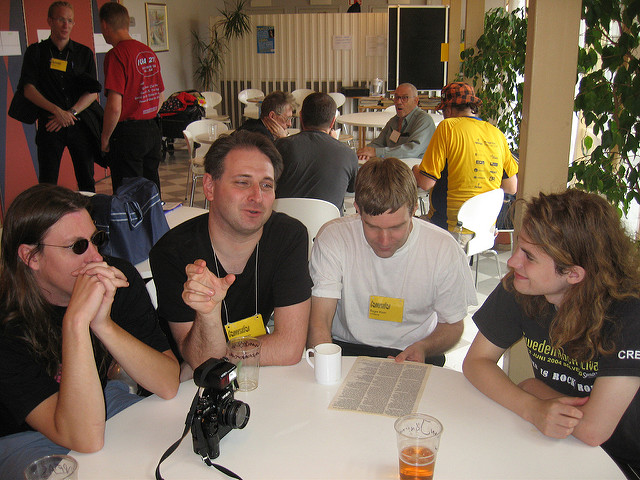
Image Credit:
Johan A
When you stand up in front of an audience to give a speech, something happens to you. You are transformed from just another person who happens to be in the room into the person that everyone is going to be listening to. What’s interesting about this transformation is that it has to have an impact on your voice also. However, sometimes when I’m listening to a speaker I’ll realize that they didn’t transform their voice and it’s impacting the speech that they are giving. Do you change your voice when you give a speech?
What Makes Giving A Speech Different?
We give speeches because we have information that we want to share with an audience. In order to make that happen, we write a speech, we practice our speech, and then we actually go ahead and stand in front of an audience and we deliver it. One of the things that a lot of speakers forget is that giving a speech is different than any other form of communication that we engage in. We are very much in control when we are giving a speech.
What this means for speakers is that we need to change the way that we speak. When we are having a conversation with a friend or a colleague, we have a tone and style of talking that we use. This cannot be the same tone and style that we use when we give a speech. Instead, we need to make some changes. When we are giving a speech, we are in charge. The tone of voice that we use needs to become an authoritarian voice. We have the answers and we’re going to be sharing them with our audience. We are NOT having a conversation with our audience.
This is exactly the problem that I see with some speakers. They don’t make the shift in tone and style that they need to make. The speech that they end up delivering comes across much more like they are having a conversation with their audience. The problem with this is that the audience does not necessarily feel as though they have to listen to a conversation. They can partially pay attention and use the rest of their brain to think about other things. As speakers this is exactly what we do not want to have happen.
How You Have To Change In Order To Give A Speech
So what’s exactly going on here? When we are in conversations with our friends, we speak in calm, measured tones. Our friends know that if they want to they can cut in and interrupt us at anytime with their thoughts. This is why when we are giving a speech we need to change things up. We need to boost the volume of our voice and the authority that our words carry.
When you are giving a speech, you are not asking for feedback or input from your audience. Instead, you are there to tell them about things that they don’t know. This is not a conversation, it’s a presentation. You want to command their attention and you can do this by shifting your voice and letting your audience know that something is different. This communication is going to be critical if you want to be able to grab and then hold on to your audience’s attention.
Body language can play a big role in clearly communicating to your audience that you are making a speech. When we are talking with friends, our bodies tend to slump and we give off a relaxed feeling. This has to change when we are giving a speech. I’m not saying that you have to be in your audience’s face, but you do need to clearly show them that you are awake, interested in what you are telling them, and engaged in your topic. Your excitement about your speech is what is going to reach them and will end up getting them excited about what you are talking about.
What All Of This Means For You
All too often I have the opportunity to watch a speaker give a speech that simply does not connect with his or her audience. There can be a number of different reasons why this can happen; however, one of the reasons that I see this happening over and over again is that the speaker is having a conversation with his or her audience, not delivering a speech.
Giving a speech is very different from having a conversation with a friend. We are then ones who are in control when we are giving a speech. When we are giving a speech, we need to change the tone and the style that we use to communicate with our audience. We need to become more authoritarian so that our audience will take the time to listen to us. The problem that some speakers have is that they don’t change their tone or delivery style from that of a conversation to that of a presentation. When giving a speech you have to change the tone of your voice so that your audience knows that you are in charge and that you are there to tell them things that they don’t know. Your body language also has to change so that your audience knows that you are not having a conversation with them.
I’m not knocking conversations, They have their place. However, when we are giving a speech, we need to make a series of changes in how we speak and our body language so that we can cause our audience to sit up and pay attention to what we are telling them. The next time that you give a speech, keep in mind that you are NOT having a conversation with your audience and shift into public speaking mode.
– Dr. Jim Anderson
Blue Elephant Consulting –
Your Source For Real World Public Speaking Skills™
Question For You: What do you think is the best way to determine if you are giving a speech or having a conversation?
![]() Click here to get automatic updates when The Accidental Communicator Blog is updated.
Click here to get automatic updates when The Accidental Communicator Blog is updated.
P.S.: Free subscriptions to The Accidental Communicator Newsletter are now available. Subscribe now: Click Here!
Note: What we talked about are advanced speaking skills. If you are just starting out I highly recommend joining Toastmasters in order to get the benefits of public speaking. Look for a Toastmasters club to join in your home town by visiting the web site www.Toastmasters.org. Toastmasters is dedicated to helping their members to understand the importance of public speaking by developing listening skills and getting presentation tips. Toastmasters is how I got started speaking and it can help you also!
What We’ll Be Talking About Next Time
So can we take just a moment and talk about being funny? It sure seems like some speakers have no problem getting their audience to laugh. They take the stage, they open their mouth, and almost instantly everyone is giggling and laughing. Then there are the rest of us. Clearly they understand the importance of public speaking. Look, I like to laugh just as much as the next person; however, getting other people to laugh has always been a bit of a challenge for me. What to say? When to say it? How to say it? Well, it turns out that there is a fairly simple way to get people to laugh – you just have to know how to twist your words.

